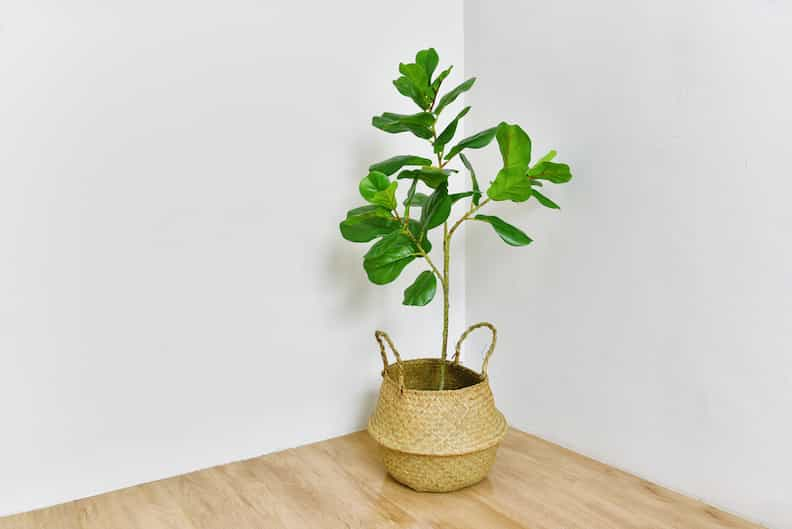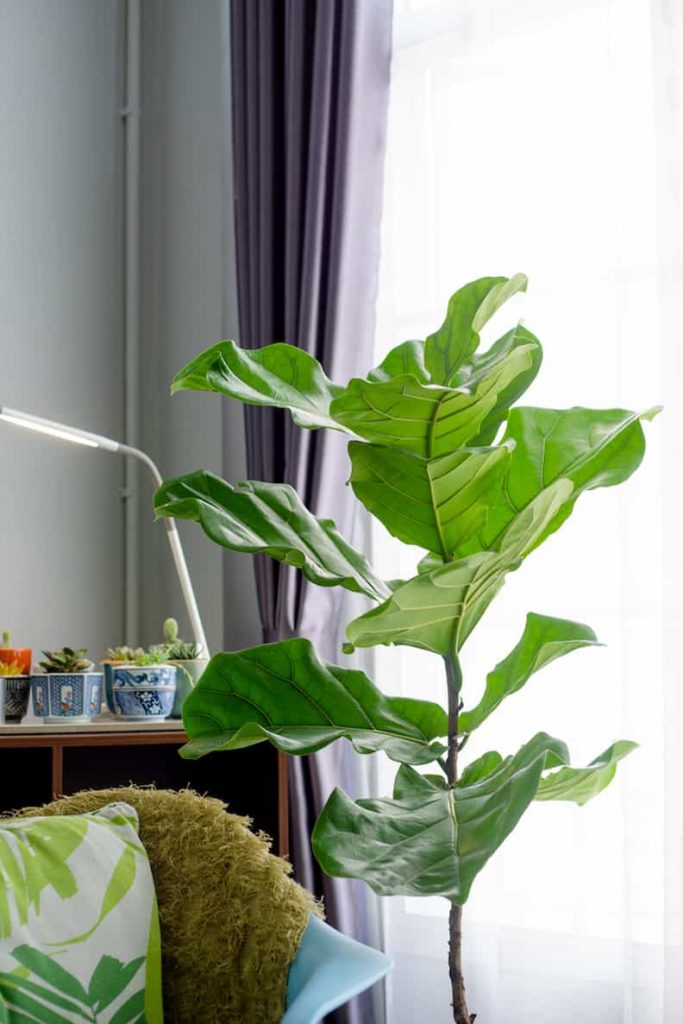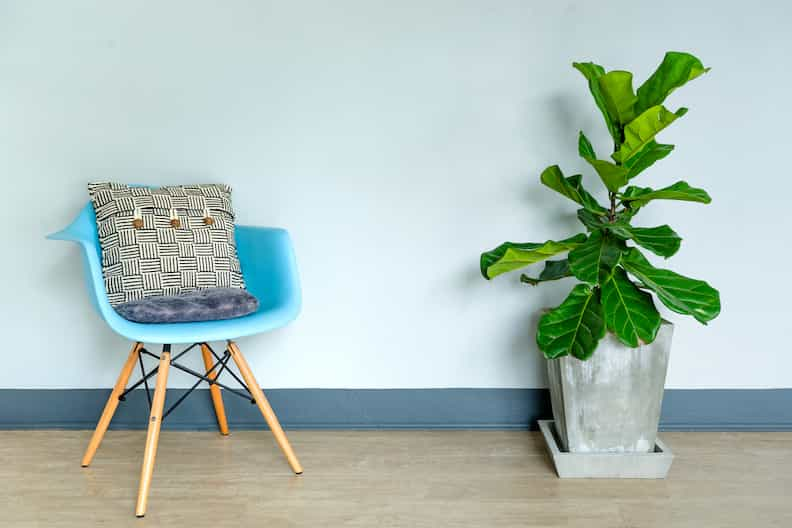Fiddle leaf figs are sought-after for their beautiful, big dark glossy leaves. They have a look quite unlike other houseplants and, in recent years, they’ve become immensely popular for this very reason. But what if (and I say this from experience!) you have a fiddle leaf fig not growing new leaves?
In this article, we’ll take a deep dive into the possible reasons why your Ficus lyrata is not producing new growth, as well as what you can do to help it along.
As you’ll see, it’s not the end of the world. In fact, in almost no time at all, you should have your fiddle leaf thriving again!

Table of Contents
Why is my fiddle leaf fig not growing new leaves?
When fiddle leaf figs refuse to grow new leaves, it’s usually related to their growing conditions and overall environment. Poorly-draining soil, irregular watering, under-fertilization, pests and diseases, insufficient light, a lack of humidity, and stress can all affect a fiddle leaf’s growth.
Fortunately, most of these issues are relatively easy to manage and resolve. The first step in the right direction is to identify the reason behind your plant’s stunted growth. Let’s look at each of these issues in greater detail, as they can all cause your fiddle leaf to stop growing.
Note: If you’re trying to save a fiddle leaf fig with no leaves, you may want to look at our article that’s specifically on that so you can take action ASAP.
1. Poorly-draining soil
One of the biggest risks fiddle leaf fig owners face is root rot and it’s often one of the main reasons why your fiddle leaf fig may not be growing new leaves.
So one way to avoid root rot in your fiddle leaf fig is to ensure it’s planted in well-draining potting mix, which has been found to be the best soil for fiddle leaf figs. While these beauties like quite a bit of water and enjoy moisture, “wet feet” from standing in pooled water will stunt their growth and cause long-term problems over time.
Best soil for Fiddle Leaf Figs
Miracle-Gro Tropical Potting Mix
Light and well-draining (perfect for avoiding root rot) while being packed with just the right nutrients – that will feed your plant for up to six months. The best soil for keeping your fiddle leaf fig healthy and strong.
The way to check this so as to grow a healthy fiddle leaf fig is to adopt quite a hands-on approach. Check to see that water runs through into your fiddle leaf’s drip tray when you water it so that you aren’t accidentally dealing with an overwatered fiddle leaf fig.
Furthermore, insert the tip of your finger into its soil from time to time to ensure that it is moist but not water-logged. Too-wet soil is clumpy and dark and may take on a foul odor.
2. Irregular watering
Fiddle leaf figs, like all plants, require water to grow and thrive. Funnily enough, this particular houseplant can be quite fussy when it comes to how often you should water a fiddle leaf fig. It likes to drink but grows its best when its topsoil layer is allowed to dry out a bit between watering sessions (no more than an inch or two at most).

To maintain a good watering regime, practice consistency. Watering every seven to ten days should suffice.
If the fiddle leaf fig’s leaves start curling up and feel dry, your plant is thirsty. Leaves that soften and turn brown at the edges indicate too much water. It may take some trial and error, but once you have your watering schedule down, stick to it.
3. Under-fertilization
Healthy fiddle leaf figs grow fast, usually in spurts, and for this reason, they require plenty of nutrition in the form of nitrogen-rich fertilizer. They cannot form and produce their big, dark green leaves without it. The whole plant will suffer as a result of this.
Under-fertilization causes existing fiddle leaf fig leaves to yellow and will noticeably slow the growth of a Ficus lyrata. Fertilize your fiddle leaf fig every few weeks during the spring and summer and taper off from feeding during the cooler months.
Best fertilizer for Fiddle Leaf Figs
Miracle-Gro Water Soluble All Purpose Plant Food
A great fertilizer with the perfect balance for your fiddle leaf fig. Simply dissolve in water and feed your plant to watch it thrive.
4. Pest infestations
The good news about fiddle leaf figs is that they are not prone to pests. On occasions, spider mites or scale may infect your plant, but these are easy to treat. If left unattended to, however, pest infestations will stunt a Ficus’s growth, including that it could be the reason why your fiddle leaf fig stops growing new leaves.
To identify pest infestations, look for any sign of visible creepy crawlies or for small holes in the leaves of fiddle leaf fig plant. Pests can be deterred with neem oil or insecticidal soap. It’s best to keep your fiddle leaf away from other plants to prevent insect infestations from spreading.
5. Diseases
The most common disease affecting fiddle leaf figs is bacterial or fungal root rot. Both of these are serious problems and can be fatal for your plant if not treated urgently. Usually, root rot results from overwatering and is indicated by brown spots appearing on your fiddle leaf fig’s leaves.
Because this disease affects roots, it’s difficult for them to carry the necessary nutrients to the rest of the plant, slowing its growth. Repotting and allowing your fiddle leaf fig’s roots to recover and dry out can solve this issue and set it on the road to recovery.
6. Insufficient light
If we look at the size of fiddle leaf fig leaves, it’s understandable that they need a fair bit of sunlight to photosynthesize and grow. But that being said, they can also be sensitive to drastic changes in light and darkness.

In general, the best spot for a fiddle leaf fig to get enough light is close to an east-facing window where it can receive constant sunlight.
At the same time, be careful that the sun it’s receiving isn’t too strong, as fiddle leaf figs may contract sunburn if left in harsh sunlight for too long, which causes leaf drop. Instead, they should be placed in areas that get six to eight hours of light per day, but preferably not bright, intense afternoon light.
7. Lack of humidity
A Ficus lyrata does best in an environment with 30 to 65% humidity. As a plant that is native to the rainforests of west and central Africa, they are used to warm climates with moist air. The good news is that most homes fall within this range.
If your fiddle leaf does not have access to humidity, it may start to brown at the edges and struggle to grow new leaves. To help it along, you can mist your plant regularly or add a humidifier to the environment.
8. Stress
Just like people, plants can be prone to stress if they experience drastic or sudden changes in their environment. If you’ve noticed that your fiddle leaf fig stopped growing after repotting, it’s actually pretty normal for moving or repotting a fiddle leaf can have an adverse (albeit temporary) effect that may cause it to lose leaves or stop growing for a few months.
For this reason, it’s always best to make changes to your fiddle leaf’s growing environment gradually. Sudden swings in temperature or light can be detrimental, as can adjustments to its watering schedule. In particular, always take great care when uprooting your fiddle leaf.
You should also make sure you’re repotting your plant at the right time of year. To find out more, take a look at our article on when to repot a fiddle leaf fig.
9. Other potential reasons why your fiddle leaf is not growing new leaves
While the above covers the main culprits, there are a few more reasons why your Ficus may be struggling to grow. It may be that your plant is rootbound, that it is affected by temperature or season, or simply that its leaves cannot breathe due to a buildup of dust or grime.
If your Ficus is in a pot that’s too small or if you’ve noticed that your fiddle leaf fig’s roots are showing, it may be rootbound and need repotting to grow (you can see some ideas for the best pots for fiddle leaf figs here).
Do this during your fiddle leaf fig’s growing season when your fiddle leaf has lots of energy. During winter and late fall, temperatures drop, slowing down the metabolic processes of fiddle leaf figs and delaying new growth.
How often do fiddle leaf figs grow new leaves?
A healthy fiddle leaf fig may experience a growth spurt as often as every 4 to 6 weeks during the spring and summer months. During winter and fall, they are unlikely to grow. Depending on the size of your plant, fiddle leaf figs produce 2 to 4 new leaves at a time, which unfurl in less than a week.
Perhaps one of the reasons we love fiddle leaf figs so much is because of their gratifying growth rate when they are healthy and in ideal environments. In peak conditions, a fiddle leaf may grow as much as 12 to 18 inches per year.

Leaves start small, shiny, and light green but unfurl and reach full size in a matter of days. For bigger fiddle leaf figs, it’s not unusual for them to grow in spurts, producing multiple leaves at a time. Growth may initially be reduced to one new leaf every few weeks for smaller plants.
Of course, the rate at which your fiddle leaf fig grows is dependent on whether or not its needs are being met. If a plant is experiencing any of the conditions outlined in the previous section, growth may be slow or stunted, and your fiddle leaf might start losing leaves.
To prevent this, keep growing guidelines in mind. In other words, if you’re not seeing new growth on your Ficus, you may need to investigate why it’s not producing so you can put measures in place to assist it.
How do you get new leaves on a fiddle leaf fig?
To get new leaves on a fiddle leaf fig, you need to ensure it is in the right conditions for growth. This includes having a good watering schedule, well-draining soil, and plenty of light and humidity in place. Giving your plant a boost of nutrients through fertilization can also help.
For lack of better phrasing, in their natural habitats, fiddle leaf figs live outside as jungle plants used to the rich, fertile soil of rainforests. Indoors, we need to try and emulate this environment as best as possible. The way to go about this is to supplement your fiddle leaf’s soil with fertilizer.
To grow a healthy fiddle leaf fig, you can give it a boost with a nitrogen-rich (organic if you can) fertilizer. This will provide it with the extra energy it cannot get from water and the sun to grow bigger and stronger. Dosing it every few weeks during the spring and summer will suffice.
Through regular fertilization, your fiddle leaf will have access to abundant nutrients that allow it to thrive, similar to how a fiddle leaf fig in the wild would do so. Generally speaking, a nutrient deficit is indicated by leaves that brown around their edges.
Mind you; you also don’t want to shock or over-fertilize your plant, so keep your feeding schedule gentle but consistent. If leaves are yellowing, followed by your fiddle leaf fig losing leaves or blackening roots, these are all signs of overfeeding, so always err on the side of less.
Do fiddle leaf figs only grow new leaves from the top?
Most often, fiddle leaf figs grow new leaves from the top. Buds develop from the plant’s center stem and are initially small and closed with a brown casing before unfurling into a light green leaf. As new leaves grow, these casings dry and fall away.
The fact that fiddle leaves grow new leaves from the top gives them their signature and much-loved “lollipop” shape. In perfect health, the Ficus lyrata can put on quite a bit of height in the course of a year. New leaves should be strong, dark green, and devoid of brown spots.

On occasion, your fiddle leaf fig may see new growth at its base. This is no cause for concern. However, to avoid having your fiddle leaf expend unnecessary energy on off-shoots, prune or pinch them off so it can redirect its attention to its top leaves.
Better yet, let your plant grow to a size appropriate for propagating your fiddle leaf fig. That way, your plant isn’t producing its wayward leaves for nothing. Do, however, attend to this before your fiddle leaf fig gets too large and turn the stem of your Ficus woody and unaesthetic.
What happens if you cut the top off a fiddle leaf fig?
The top of a fiddle leaf fig’s stem has a fast growth rate and is most often where new leaves arise. By cutting off the top of a fiddle leaf fig, you force it to try and put out new growth, usually towards the sides. This may result in a single new branch or multiple new branches.
Whatever your reasons, knowing how to prune your fiddle leaf fig can be healthy for your plant. Often, it is a prerequisite for new growth, especially if your fiddle leaf fig has experienced a period of ill health. You may also need to shape your plant or reduce its size.
Cutting off the top of your fiddle leaf fig, where most of its energy is used, can cause it to have an often much-needed and robust growth spurt. Of course, you shouldn’t prune away too much of your plant at any given time. Anything exceeding 30% can cause permanent damage.

For those with bigger fiddle leaf figs that are looking to help it branch outward, cutting off the plant’s top is the way to go. To make up for this deficit, a fiddle leaf fig will try to compensate with new growth, usually in the form of sidewards growing buds.
For best results, wait until your Ficus is sizeable (three feet/one meter plus) before topping it. Then, cut into the woodier part of the stem rather than the softer, greener tip. Regrowth may be slow, but this technique usually results in multiple buds rather than just one.
How can I make my fiddle leaf grow faster?
To make your fiddle leaf grow faster, you need to provide it with ideal growing conditions. This includes making sure it is planted in a container that is an appropriate size. Your fiddle leaf fig also needs to receive plenty of food, water, and sunlight. Good soil is crucial.
(As you may have noticed, these are basically the same requirements that you should be following if you’re trying to fix a fiddle leaf fig that isn’t growing new leaves.)
While these beauties have a reputation for being finicky, their care regime is quite simple, so long as their main needs are met. A happy, well-looked-after plant should have no trouble thriving. Let’s investigate how to make fiddle leaf figs grow faster.
1. Make sure it’s in an appropriately-sized pot
Given their growth rate, fiddle leaf figs outgrow their pots quite easily. Therefore, it is paramount that they are repotted once they get too big or a) they’ll become rootbound, and b) they won’t be able to grow.
When repotting, always select a pot that is at least twice the size of your Ficus’s root ball. Together with this, make sure it has plenty of drainage holes. Adding a layer of gravel to the bottom of your pot will better distribute moisture, too.

2. Fertilize regularly
Fiddle leaf figs expend a tremendous amount of energy to grow. Often, the soil we purchase at nurseries or have in our gardens is not sufficiently nutrient-rich to help them on their way.
To give your plant a boost and help it grow faster, you can supplement its soil with a nitrogen-rich fertilizer. To avoid shocking or stressing your plant, use smaller quantities of fertilizer over extended periods during your fiddle leaf’s growing months.
3. Sun, water, and soil
This almost goes without saying, but the best way to promote growth in a fiddle leaf fig is simple to make sure it has ample sun, water, and good-quality soil. Without sunlight, a fiddle leaf fig is unable to photosynthesize, and without water, nutrients cannot reach its stem and leaves.
Furthermore, to deter pests and diseases, you want to keep your fiddle leaf growing in well-maintained, good-quality soil that drains excess water. This lessens the chance of fungal and bacterial infections forming in your fiddle leaf fig’s soil.
Final thoughts on what to do if your fiddle leaf is not growing new leaves
If your fiddle leaf fig has stopped growing new leaves, that’s usually a pretty clear indicator that something’s wrong. Fortunately, as you’ve hopefully seen, this basically comes down to a process of elimination to find what the culprit may be.
Once you’ve narrowed down the possible options, it’s simply a case of correcting whatever has caused the problem. For example, has your fiddle leaf fig stopped growing after repotting? Some repotting shock is pretty normal for ficus, so give it some time to adjust to its new home and things should be fine.
Alternatively, things like drainage issues should be fixed fairly quickly, as root rot is a serious problem for this plant. But whatever is causing this problem, once you have addressed it, your fiddle leaf fig should go back to its happy, thriving self.


